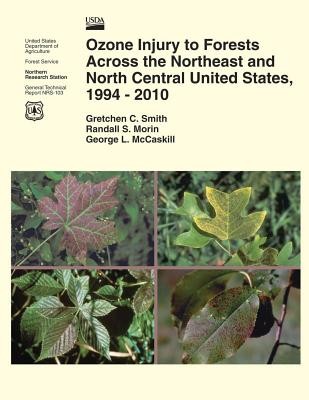
- We will send in 10–14 business days.
- Author: United States Department of Agriculture
- Publisher: CreateSpace Independent Publishing Platform
- Year: 2015
- Pages: 50
- ISBN-10: 1505847354
- ISBN-13: 9781505847352
- Format: 21.6 x 27.9 x 0.3 cm, softcover
- Language: English
- SAVE -10% with code: EXTRA
Ozone Injury to Forests Across the Northeast and North Central United States, 1994-2010 (e-book) (used book) | bookbook.eu
Reviews
Description
Ozone is a highly toxic air contaminant that has been shown to decrease tree growth and cause signifi cant disturbance to forested ecosystems. Ozone also causes distinct foliar injury symptoms to certain species (bioindicator plants) that can be used to detect and monitor ozone stress (biomonitoring) in the forest environment. In the early 1990s, the U.S. Forest Service, in partnership with the U.S. Environmental Protection Agency, developed and implemented a suite of forest health indicators to respond to emerging demands for a comprehensive assessment of the health of U.S. forests. This report focuses on the states in the Northern Research Station-Forest Inventory and Analysis region, which has the longest record of ozone biomonitoring in the country, from 1994 through 2010. The results of 17 years of ozone injury detection provide indisputable evidence that ozone-induced foliar injury symptoms occur routinely on ozone-sensitive bioindicator plants across much of the forested landscape and in areas previously thought to be relatively ozone free. This report provides state-level information on where ozone stress occurs and whether ozone stress is increasing or decreasing over time. It also provides state-level estimates of the acres of forest land and volume of ozone-susceptible species at risk of ozone impact.
EXTRA 10 % discount with code: EXTRA
The promotion ends in 18d.07:08:26
The discount code is valid when purchasing from 10 €. Discounts do not stack.
- Author: United States Department of Agriculture
- Publisher: CreateSpace Independent Publishing Platform
- Year: 2015
- Pages: 50
- ISBN-10: 1505847354
- ISBN-13: 9781505847352
- Format: 21.6 x 27.9 x 0.3 cm, softcover
- Language: English English
Ozone is a highly toxic air contaminant that has been shown to decrease tree growth and cause signifi cant disturbance to forested ecosystems. Ozone also causes distinct foliar injury symptoms to certain species (bioindicator plants) that can be used to detect and monitor ozone stress (biomonitoring) in the forest environment. In the early 1990s, the U.S. Forest Service, in partnership with the U.S. Environmental Protection Agency, developed and implemented a suite of forest health indicators to respond to emerging demands for a comprehensive assessment of the health of U.S. forests. This report focuses on the states in the Northern Research Station-Forest Inventory and Analysis region, which has the longest record of ozone biomonitoring in the country, from 1994 through 2010. The results of 17 years of ozone injury detection provide indisputable evidence that ozone-induced foliar injury symptoms occur routinely on ozone-sensitive bioindicator plants across much of the forested landscape and in areas previously thought to be relatively ozone free. This report provides state-level information on where ozone stress occurs and whether ozone stress is increasing or decreasing over time. It also provides state-level estimates of the acres of forest land and volume of ozone-susceptible species at risk of ozone impact.


Reviews